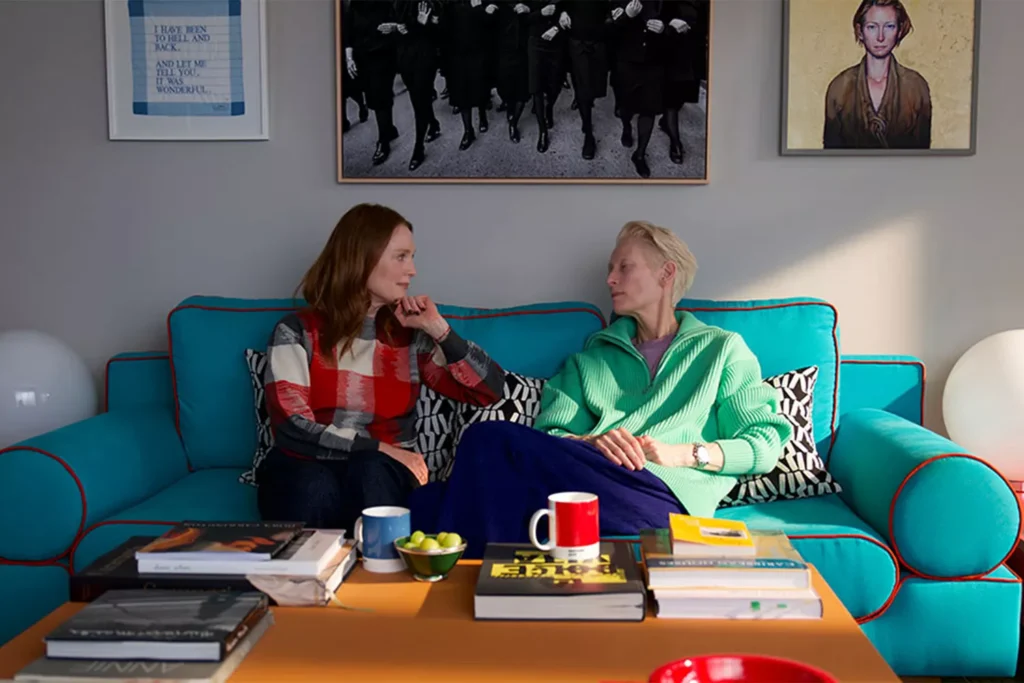Table of Contents
The realm of cinema has long been a space where complex emotions, life’s toughest questions, and human experiences are explored. In Pedro Almodóvar’s English-language debut, The Room Next Door, these concepts are probed through the poignant story of two old friends confronting life, death, and everything in between. Julianne Moore and Tilda Swinton headline this quiet, reflective drama that centers on the beauty of friendship, the inevitability of death, and the struggle for understanding in the face of loss.
A Heartfelt Story of Friendship and Death
At its core, The Room Next Door is about the intimate bond between Ingrid (played by Moore) and Martha (played by Swinton). The two reconnect when Martha, a former war correspondent, is hospitalized with terminal cancer. This reunion sets the stage for deep conversations about their shared past, lovers, regrets, and, most notably, death. However, this isn’t just a tale of somber reflection — the film offers a nuanced look at life’s beauties as well.
Almodóvar’s First English Language Film
While The Room Next Door is Almodóvar’s first foray into English-language cinema, the shift in language does not detract from his signature style. Known for his vibrant, often surreal explorations of grief, beauty, and madness, Almodóvar manages to retain his stylistic flair while offering a more subdued, introspective film than his previous works. Fans of his films like All About My Mother or Volver will recognize the emotional depth and female-driven narratives, even though this film feels quieter and more contemplative.
An Adaptation of Sigrid Nunez’s Novel
The Room Next Door is adapted from Sigrid Nunez’s novel, diving deep into themes of friendship, grief, and the confrontation with death. The novel’s contemplative nature translates well to the screen, with Almodóvar crafting a pensive atmosphere that allows the audience to sit with the characters as they process their emotions. Like Nunez’s other works, including The Friend, this film meditates on loss without resorting to melodrama.
Julianne Moore’s Anxiety vs. Tilda Swinton’s Serenity
The heart of the film rests in the performances of Moore and Swinton, who are electric on screen together. Moore’s Ingrid is a bundle of raw nerves, consumed by a fear of death that she cannot escape. Her anxiety contrasts sharply with Swinton’s Martha, who exudes a calm, peaceful acceptance of her mortality. Watching these two characters grapple with their opposing worldviews is riveting, as they reflect different ways of approaching the end of life.
The Room Next Door: A Test of Friendship
The film’s emotional crux comes when Martha asks Ingrid to be present in “the room next door” as she ends her life with a euthanasia pill. For Ingrid, this request is almost unbearable — she cannot comprehend how her friend can face death with such calmness. Her inner turmoil is palpable as she wrestles with the morality of euthanasia and the fear of losing someone so close.

Euthanasia Without Moral Judgment
One of the most striking aspects of The Room Next Door is how it handles the theme of euthanasia. Instead of diving into a moral debate about the right to die, Almodóvar chooses to focus on the emotional impact of this decision on both women. The film isn’t about whether Martha is right or wrong for choosing to end her life on her terms, but about the profound sense of responsibility and fear that Ingrid faces in witnessing her friend’s final act.
The Power of Showing Up
At its core, The Room Next Door is about showing up for the people you care about, even when you don’t fully understand their choices. Ingrid and Martha’s friendship is not rooted in perfect understanding but in a shared history and the love they have for one another. Ingrid’s journey in the film is not about coming to terms with Martha’s decision but about being present for her in her final moments, no matter how hard that is.
Nature, Beauty, and Mortality
One of the most visually stunning aspects of The Room Next Door is the way Almodóvar juxtaposes the theme of death with scenes of natural beauty. Martha is shown taking in the beauty of the world — the trees, the birds, the colors of the sunset — as she prepares to leave it behind. These scenes are a reminder that life, even in its final moments, can be filled with beauty and peace.
John Turturro’s Unique Role
In addition to the two central performances, John Turturro plays Damian, a fellow writer who is obsessed with the idea that the world is ending due to climate change. While his perspective adds a layer of nihilism to the story, it contrasts with Martha’s more serene acceptance of death. Turturro’s Damian adds a philosophical layer to the film, questioning the value of life in a world facing destruction.
Quiet Cinematic Techniques
Unlike some of his more visually extravagant works, Almodóvar adopts a quieter approach in The Room Next Door. Much of the film is composed of close-ups and medium shots, emphasizing the characters’ emotions and their intimate interactions. This reserved style allows the audience to feel fully immersed in the private world of Ingrid and Martha.
Read More: Selling Sunset Season 8 Shocker: The Scandalous Rumour Nicole Young Spread About Emma Hernan
The Subtle Use of Color
While the film is more muted than many of Almodóvar’s other works, he still incorporates his love of vibrant colors, particularly in the costume design. Bright, cheerful outfits stand in contrast to the film’s serious subject matter, creating a visual tension that reflects the emotional turmoil of the characters. This contrast mirrors the vibrancy of life even as it approaches its end.
Exploring Grief, Connection, and Acceptance
As the film unfolds, it becomes clear that The Room Next Door is less about death itself and more about the relationships we build along the way. Ingrid’s fear and Martha’s calm acceptance show two different reactions to the end of life, but both are rooted in the deep, human need for connection. It’s a meditation on the importance of being present, even when we don’t have all the answers.
Read More: Revolutionary Travel: The 2025 Atlantis Carbon 595 Monocoque Motorhome
A Story That Encourages Reflection
For viewers, The Room Next Door is a film that encourages self-reflection. As we watch Ingrid struggle with her fear of death, we might find ourselves questioning how we would react in her shoes. The film doesn’t offer easy answers, but it does ask us to consider how we face our own mortality and how we support others in doing the same.
The Final Verdict: A Quiet Masterpiece
While The Room Next Door may not have the bombastic energy of some of Almodóvar’s earlier films, it stands as a quiet masterpiece. Moore and Swinton are nothing short of brilliant, and Almodóvar’s restraint allows their performances to shine. It’s a film that asks big questions about life, death, and friendship, but does so in a way that is both gentle and profound.
Conclusion
In The Room Next Door, Pedro Almodóvar crafts a tender, reflective film about the complexities of friendship and the inevitability of death. With breathtaking performances from Julianne Moore and Tilda Swinton, the film captures the nuanced emotional landscape of two women facing life’s ultimate challenge. It’s a film that stays with you, inviting you to contemplate your own relationships and the nature of life and death.
FAQs
1. What is The Room Next Door about?
The Room Next Door is about two old friends, Ingrid and Martha, who reconnect as Martha faces terminal cancer. It explores themes of friendship, mortality, and the fear of death.
2. Is The Room Next Door based on a book?
Yes, the film is adapted from a novel by Sigrid Nunez.
3. How does the film handle the topic of euthanasia?
The film doesn’t focus on the morality of euthanasia but instead portrays it as a personal decision made by Martha, exploring the emotional impact on those around her.
4. What is unique about Pedro Almodóvar’s approach in this film?
Unlike some of his more visually extravagant films, Almodóvar adopts a quieter, more introspective style in The Room Next Door, letting the performances take center stage.
5. Who else stars in the film besides Moore and Swinton?
John Turturro plays a supporting role as Damian, a writer obsessed with the world’s impending doom due to climate change.


[…] How ‘The Room Next Door’ Showcases the Complex Ties Between Friendship and Death with Ju… […]